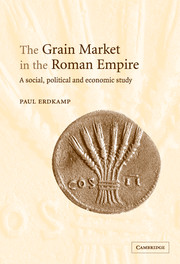Book contents
- Frontmatter
- Contents
- List of maps
- Acknowledgements
- Map 1 Asia Minor
- Map 2 Greece
- Map 3 Italy
- Map 4 The Roman World
- Map 5 Egypt
- Introduction
- 1 Production and productivity in Roman agriculture
- 2 The world of the smallholder
- 3 Farmers and their market relations
- 4 Market integration: connecting supply and demand
- 5 Rome and the corn provinces
- 6 Urban food supply and grain market intervention
- Conclusions
- References
- General index
- Index locorum
- References
References
Published online by Cambridge University Press: 04 November 2009
- Frontmatter
- Contents
- List of maps
- Acknowledgements
- Map 1 Asia Minor
- Map 2 Greece
- Map 3 Italy
- Map 4 The Roman World
- Map 5 Egypt
- Introduction
- 1 Production and productivity in Roman agriculture
- 2 The world of the smallholder
- 3 Farmers and their market relations
- 4 Market integration: connecting supply and demand
- 5 Rome and the corn provinces
- 6 Urban food supply and grain market intervention
- Conclusions
- References
- General index
- Index locorum
- References
- Type
- Chapter
- Information
- The Grain Market in the Roman EmpireA Social, Political and Economic Study, pp. 331 - 355Publisher: Cambridge University PressPrint publication year: 2005



